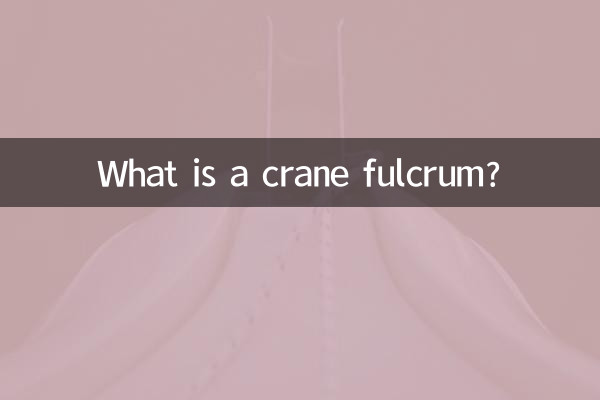What is a crane fulcrum?
In the field of construction machinery, cranes are indispensable and important equipment, and their fulcrums, as key components of support and balance, directly affect the safety and stability of the crane. This article will combine the hot topics and hot content on the entire network in the past 10 days, analyze in detail the definition, function, type and related technical parameters of the crane fulcrum, and present it through structured data.
1. Definition and function of crane fulcrum

The fulcrum of a crane refers to the point where the equipment comes into contact with the ground or other supporting surfaces during operation, which is used to distribute the load and maintain balance. The design and arrangement of the fulcrum directly affects the stability and lifting capacity of the crane. The following is the core role of pivots:
1.spread the load: Distribute the weight of the crane to a larger contact area through multiple fulcrums to reduce the pressure on the ground.
2.keep balance: During hoisting operations, the fulcrum helps the crane resist the overturning moment and ensures the stability of the equipment.
3.Adapt to the terrain: By adjusting the height or position of the fulcrum, the crane can operate safely on uneven ground.
2. Common types of crane fulcrums
Fulcrum designs vary depending on the type and purpose of the crane. The following are common pivot types and their characteristics:
| Type | Features | Applicable scenarios |
|---|---|---|
| fixed legs | Simple structure, high stability, but limited adjustment ability | Small crane or fixed working scene |
| Hydraulic legs | Telescopically adjustable, adaptable to different terrains, easy to operate | Mobile cranes, truck cranes, etc. |
| crawler pivot | Large contact area, strong load-bearing capacity, slow movement | Large crawler crane |
| floating pivot | Suitable for water operations and can be adjusted as the water level changes | Marine crane or floating crane |
3. Technical parameters of crane fulcrum
The design of the crane fulcrum needs to consider a number of technical parameters to ensure safety and efficiency. The following are examples of key parameters:
| Parameter name | Description | Typical value |
|---|---|---|
| Number of pivots | Total number of crane support points | 4-6 (common in car cranes) |
| Fulcrum span | horizontal distance between pivot points | 5-10 meters (depending on the model) |
| Maximum ground pressure | The maximum pressure exerted by a single fulcrum on the ground | 10-50 tons/square meter |
| Adjustment range | Telescopic length of hydraulic legs | 0.5-3 meters |
4. Analysis of the correlation between hot topics on the entire network and crane fulcrums
In the past 10 days, crane-related topics have mainly focused on safe operation and technological innovation. The following is the relationship between hot content and pivot points:
1.Safety incident warning: At a construction site, a crane overturned due to incomplete outriggers, triggering a discussion on the fulcrum inspection process.
2.Intelligent outrigger system: A manufacturer has launched automatic leveling hydraulic outriggers that monitor ground conditions in real time through sensors to improve safety.
3.Environmentally friendly design: New composite outriggers reduce weight and ground pressure, becoming a hot topic in green construction.
5. Future development trends of crane fulcrums
As technology advances, crane fulcrum design will develop in the following directions:
1.Intelligent: Integrate sensors and AI algorithms to achieve automatic leveling and load monitoring.
2.Lightweight: Use high-strength materials to reduce the weight of the legs and improve movement efficiency.
3.Modular: Quick disassembly and assembly design to adapt to diverse operating scenarios.
Through the above analysis, it can be seen that the crane fulcrum is not only a part of the mechanical structure, but also the core guarantee of safety and efficiency. The integration of future technologies will further promote its performance improvement.

check the details

check the details